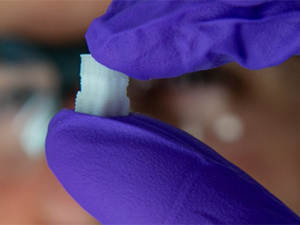



Date:01/04/19
 For some time now, we've been hearing about implantable scaffolding-like material that helps heal injuries to bones. Scientists have now developed a new type of that material, aimed specifically at difficult-to-treat osteochondral injuries.
For some time now, we've been hearing about implantable scaffolding-like material that helps heal injuries to bones. Scientists have now developed a new type of that material, aimed specifically at difficult-to-treat osteochondral injuries.
The long bones in our arms and legs have a layer of smooth, compressible cartilage at each end, which gradually transitions to hard bone underneath. This dual-density combo is known as osteochondral tissue, and when it develops cracks or otherwise gets damaged, conditions such as disabling arthritis can result. Although such injuries frequently afflict athletes, they can occur in pretty much anyone.
For injuries to more uniform types of bone, various scientific institutions have created the previously-mentioned scaffolding. Implanted at the injury site, the three-dimensional material basically provides a roosting site for bone cells, helping them to move in from the adjacent bone and start reproducing. Eventually, they simply take over from the material, replacing it as it harmlessly dissolves.
Now, researchers from the University of Maryland and Houston-based Rice University have developed a version of this material that's tailored to healing osteochondral tissue.
Sean Bittner examines a sample of the material
Fabricated by a 3D printer, it's composed partly of a soft polymer with a cartilage-like consistency, which transitions to a bone-like hard ceramic. A network of pores within both substances let cartilage and bone cells migrate into them, plus those pores also allow for the infiltration of blood vessels.
The scientists are now looking at methods of printing implants that precisely fit each patient's specific injury. Ultimately, they hope that the technology could improve peoples' lives.
"Athletes are disproportionately affected by these injuries, but they can affect everybody," says Rice bioengineering grad student Sean Bittner. "I think this will be a powerful tool to help people with common sports injuries."
Bittner and Rice bioengineer Antonios Mikos are leading the research, which is described in a paper that was published this week in the journal Acta Biomaterialia.
3D-printed material is designed to treat difficult bone injuries
 For some time now, we've been hearing about implantable scaffolding-like material that helps heal injuries to bones. Scientists have now developed a new type of that material, aimed specifically at difficult-to-treat osteochondral injuries.
For some time now, we've been hearing about implantable scaffolding-like material that helps heal injuries to bones. Scientists have now developed a new type of that material, aimed specifically at difficult-to-treat osteochondral injuries.The long bones in our arms and legs have a layer of smooth, compressible cartilage at each end, which gradually transitions to hard bone underneath. This dual-density combo is known as osteochondral tissue, and when it develops cracks or otherwise gets damaged, conditions such as disabling arthritis can result. Although such injuries frequently afflict athletes, they can occur in pretty much anyone.
For injuries to more uniform types of bone, various scientific institutions have created the previously-mentioned scaffolding. Implanted at the injury site, the three-dimensional material basically provides a roosting site for bone cells, helping them to move in from the adjacent bone and start reproducing. Eventually, they simply take over from the material, replacing it as it harmlessly dissolves.
Now, researchers from the University of Maryland and Houston-based Rice University have developed a version of this material that's tailored to healing osteochondral tissue.
Sean Bittner examines a sample of the material
Fabricated by a 3D printer, it's composed partly of a soft polymer with a cartilage-like consistency, which transitions to a bone-like hard ceramic. A network of pores within both substances let cartilage and bone cells migrate into them, plus those pores also allow for the infiltration of blood vessels.
The scientists are now looking at methods of printing implants that precisely fit each patient's specific injury. Ultimately, they hope that the technology could improve peoples' lives.
"Athletes are disproportionately affected by these injuries, but they can affect everybody," says Rice bioengineering grad student Sean Bittner. "I think this will be a powerful tool to help people with common sports injuries."
Bittner and Rice bioengineer Antonios Mikos are leading the research, which is described in a paper that was published this week in the journal Acta Biomaterialia.
Views: 388
©ictnews.az. All rights reserved.Similar news
- Azerbaijani project to monitor disease via mobile phones
- Innovative educational system to be improved under presidential decree
- NTRC prolongs license of two TV and radio organizations for 6 years
- Azerbaijan establishes e-registry for medicines
- Azerbaijani museum introduces e-guide
- Nar Mobile opens “Nar Dunyasi” sales and service center in Siyazan city
- International conference on custom electronic services held in Baku
- OIC secretary general to attend COMSTECH meeting in Baku
- Azerbaijan develops earthquake warning system
- New law to regulate transition to digital broadcasting in Azerbaijan
- Azerbaijani State Social Protection Fund introduces electronic digital signature
- Intellectual traffic management system in Baku to be commissioned in December
- Tax Ministry of Azerbaijan started receiving video-addresses
- World Bank recommends Azerbaijan to speed up e-service introduction in real estate
- Azerbaijan to shift to electronic registration of real estate





















